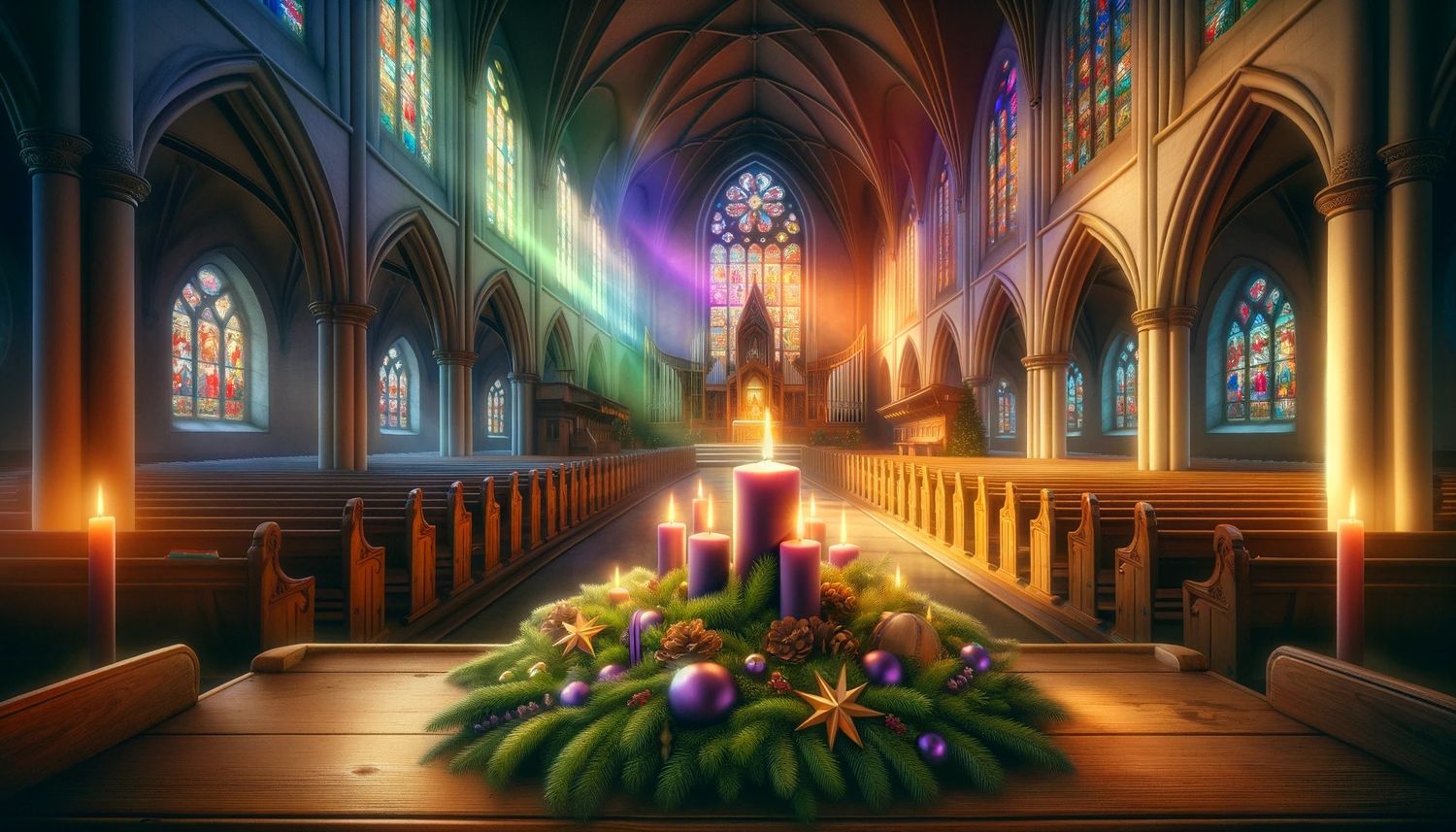Home>Special Themes>What Do You Do In Advent


Special Themes
What Do You Do In Advent
Published: February 14, 2024
Jason DeRose, Managing Editor at Christian.net, uses his expertise in religion and journalism to deepen understanding of faith's societal impacts. His editorial leadership, coupled with a strong academic background, enriches the platform’s diverse content, earning him recognition in both journalism and religious circles.
Discover the significance of special themes and activities during Advent. Find out how to make the most of this special time of year. Explore traditions and celebrations.
(Many of the links in this article redirect to a specific reviewed product. Your purchase of these products through affiliate links helps to generate commission for Christian.net, at no extra cost. Learn more)
Table of Contents
Introduction
Advent is a time of joyful anticipation and spiritual preparation observed by Christians around the world. It marks the beginning of the liturgical year and is a period of four weeks leading up to Christmas. The word "Advent" is derived from the Latin word "adventus," meaning "coming" or "arrival," and it symbolizes the coming of Jesus Christ into the world. This sacred season is a time for reflection, hope, and expectation as believers prepare their hearts to celebrate the birth of Jesus.
During Advent, Christians focus on the dual nature of this season. On one hand, they commemorate the historical event of Jesus' birth in Bethlehem over two thousand years ago. On the other hand, they also look forward to the promised return of Christ in the future. This duality infuses the season with a sense of both historical significance and future hope, making it a time of profound spiritual significance for believers.
As the world outside becomes adorned with festive decorations and the air fills with the sounds of holiday cheer, the observance of Advent invites individuals to pause and engage in a deeper, more contemplative journey. It serves as a counterpoint to the hustle and bustle of the secular holiday season, offering a space for introspection, prayer, and spiritual growth.
Throughout the centuries, Advent has been a time for believers to rekindle their faith, renew their commitment to living out the teachings of Jesus, and to prepare their hearts to welcome the Christ child. It is a season of waiting, watching, and preparing for the coming of the Messiah, both in the humble manger of Bethlehem and in the promised fulfillment of God's kingdom.
In the following sections, we will delve into the rich traditions, symbols, and practices associated with Advent, exploring the ways in which this sacred season continues to inspire and uplift individuals and communities around the world. Join us on this journey of discovery as we uncover the beauty and significance of Advent.
Read more: What Do Catholics Do For Advent
The Meaning of Advent
Advent, a cherished season in the Christian calendar, holds profound significance as it symbolizes the period of expectant waiting and preparation for the celebration of the birth of Jesus Christ. This sacred time, typically spanning four weeks, serves as a poignant reminder of the anticipation and hope that characterized the world before the arrival of the Messiah.
At its core, Advent encapsulates the essence of hope, love, joy, and peace. It invites believers to reflect on the profound impact of Jesus' birth and to contemplate the enduring message of salvation and redemption that it represents. The season also serves as a poignant reminder of the humble circumstances surrounding the birth of Jesus, emphasizing the values of simplicity, humility, and compassion.
The lighting of the Advent candles, often accompanied by readings and prayers, symbolizes the progressive illumination of the world through the arrival of Jesus, who is often referred to as the "Light of the World." Each candle represents a different aspect of the Advent journey, such as hope, love, joy, and peace, and their sequential lighting serves as a visual representation of the increasing brightness and anticipation as Christmas draws near.
Furthermore, Advent encourages believers to engage in introspection and spiritual preparation, fostering a sense of mindfulness and reverence amidst the festive activities of the holiday season. It prompts individuals to examine their lives, renew their faith, and rekindle their connection with the divine, fostering a deeper appreciation for the profound spiritual significance of Christmas.
In essence, the meaning of Advent extends beyond the historical commemoration of Jesus' birth; it embodies a timeless message of hope, renewal, and anticipation. It serves as a poignant reminder of the enduring impact of Jesus' life and teachings, inspiring believers to embody the values of compassion, generosity, and faith as they prepare to celebrate the birth of the Savior.
As we delve deeper into the traditions and practices associated with Advent, we will uncover the rich tapestry of customs and symbols that continue to enrich this sacred season, offering a source of spiritual nourishment and inspiration for individuals and communities worldwide. Join us on this journey as we explore the profound significance of Advent and the enduring message of hope and renewal that it embodies.
Advent Traditions
Advent is steeped in rich traditions that have been cherished by generations of believers, each one carrying profound symbolism and spiritual significance. These traditions serve as a poignant reminder of the timeless values and enduring hope that characterize the Advent season. As families and communities come together to observe these customs, they are enveloped in a sense of reverence and anticipation, fostering a deeper connection to the spiritual essence of Christmas.
One of the most iconic Advent traditions is the lighting of the Advent wreath. This circular wreath, typically adorned with evergreen foliage and four candles, represents the eternal nature of God and the hope brought by the arrival of Jesus Christ. Each candle holds symbolic meaning, with the first candle, often purple, representing hope, the second, also purple, representing love, the third, pink, representing joy, and the fourth, purple, representing peace. As the weeks of Advent progress, these candles are sequentially lit, signifying the increasing anticipation and illumination as Christmas draws near.
Another beloved tradition is the Advent calendar, which traces its origins to 19th-century Germany. These calendars, often adorned with festive imagery, contain numbered doors or pockets, each concealing a small treat or religious symbol. As each day of Advent unfolds, individuals, particularly children, eagerly open a new door, savoring the anticipation and joy of the season. This tradition serves as a delightful way to count down the days until Christmas while instilling a sense of wonder and excitement.
Advent devotions, including special prayers, scripture readings, and reflections, are also integral to the observance of this sacred season. Many families and communities gather for Advent services, where they engage in communal prayer and contemplation, fostering a sense of unity and spiritual connection. These devotions provide a space for individuals to pause amidst the busyness of the holiday season, allowing them to center their hearts and minds on the profound significance of Jesus' birth.
Furthermore, Advent activities such as crafting nativity scenes, engaging in acts of charity, and participating in Advent-themed musical performances serve to deepen the spiritual experience of the season. These activities not only foster a sense of creativity and community but also reinforce the values of compassion, generosity, and gratitude, which lie at the heart of the Advent message.
In essence, Advent traditions serve as a tapestry of spiritual practices and customs that enrich the observance of this sacred season. They provide a framework for believers to engage in meaningful rituals, fostering a deeper connection to the timeless message of hope, love, joy, and peace that permeates the Advent season. As we continue to explore the beauty and significance of Advent, let us embrace these cherished traditions, allowing them to illuminate our hearts and minds as we prepare to celebrate the birth of the Savior.
Advent Wreath
The Advent wreath stands as a timeless symbol of the hope and anticipation that characterize the Advent season. Comprising a circular wreath typically crafted from evergreen foliage, the Advent wreath holds profound significance as it embodies the eternal nature of God and the promise of new life brought by the birth of Jesus Christ. At the center of this wreath are four candles, each representing a different aspect of the Advent journey: hope, love, joy, and peace.
The lighting of the Advent wreath candles is a cherished tradition that unfolds over the four weeks leading up to Christmas. The first candle, often purple, symbolizes hope and serves as a poignant reminder of the anticipation and expectation that permeate the Advent season. As the first candle is lit, it illuminates the darkness, signifying the hope brought by the imminent arrival of Jesus, the Light of the World.
The second candle, also purple, represents love, embodying the profound message of God's unconditional love for humanity. As this candle is kindled, it serves as a beacon of love, inspiring believers to reflect on the transformative power of divine love and the enduring significance of Jesus' birth.
The third candle, often pink, symbolizes joy, infusing the Advent season with a sense of celebration and exuberance. Its lighting signifies the growing anticipation and rejoicing as Christmas draws near, inviting individuals to embrace the joyous message of the Savior's imminent arrival.
The fourth candle, again purple, represents peace, offering a profound reminder of the tranquility and harmony brought by the presence of Jesus in the world. As this candle is lit, it symbolizes the culmination of the Advent journey, enveloping believers in a sense of peace and serenity as they prepare to celebrate the birth of the Prince of Peace.
As each week of Advent unfolds, these candles are sequentially lit, symbolizing the progressive illumination of the world through the arrival of Jesus, who is often referred to as the "Light of the World." The increasing brightness of the Advent wreath serves as a visual representation of the growing anticipation and joy as Christmas approaches, infusing the season with a sense of spiritual significance and reverence.
In essence, the Advent wreath serves as a poignant symbol of the hope, love, joy, and peace that characterize the Advent season. Its timeless tradition invites believers to engage in a journey of spiritual preparation and anticipation, fostering a deeper connection to the profound significance of Jesus' birth. As we gather around the Advent wreath, we are reminded of the enduring message of hope and renewal that permeates the season, inspiring us to embrace the timeless values it represents.
Advent Calendar
The Advent calendar stands as a beloved tradition that adds an element of excitement and anticipation to the observance of the Advent season. Originating in 19th-century Germany, the Advent calendar has evolved into a cherished custom embraced by families and communities worldwide. This delightful tradition serves as a tangible representation of the countdown to Christmas, infusing each day of Advent with a sense of wonder and joy.
Typically, an Advent calendar consists of a decorative display featuring numbered doors or pockets, each concealing a small treat or religious symbol. As the days of Advent unfold, individuals eagerly open a new door, savoring the anticipation and delight of discovering the hidden surprise within. This simple yet meaningful ritual serves to heighten the sense of expectation and joy as Christmas draws near, particularly for children who eagerly engage in this daily tradition.
The Advent calendar serves as a tangible reminder of the passage of time, allowing individuals to mark each day leading up to Christmas with a sense of purpose and excitement. Whether adorned with festive imagery or religious motifs, the calendar serves as a visual representation of the journey toward the celebration of Jesus' birth, fostering a deeper connection to the spiritual essence of the season.
Beyond its role as a countdown to Christmas, the Advent calendar also provides an opportunity for families to engage in meaningful discussions and reflections. As each door is opened, families can gather to read scripture passages, share stories of the season, or engage in acts of kindness and generosity. This interactive approach to Advent fosters a sense of togetherness and spiritual enrichment, allowing individuals to deepen their understanding of the significance of Jesus' birth while creating lasting memories with loved ones.
Moreover, the Advent calendar serves as a delightful way to cultivate a spirit of giving and gratitude. Whether through the exchange of small treats, acts of service, or expressions of love, the calendar encourages individuals to embrace the values of compassion and generosity that lie at the heart of the Advent message. This tradition instills a sense of mindfulness and appreciation for the blessings of the season, fostering a spirit of joy and goodwill.
In essence, the Advent calendar serves as a cherished tradition that infuses the observance of Advent with a sense of anticipation, joy, and spiritual enrichment. As each door is opened, it serves as a gentle reminder of the timeless message of hope and renewal that permeates the season, inspiring individuals to embrace the values of love, kindness, and faith as they prepare to celebrate the birth of the Savior.
Read more: What Do You Do With An Advent Wreath
Advent Devotions
Advent devotions hold a central place in the observance of the Advent season, offering a profound opportunity for believers to engage in spiritual reflection, prayer, and contemplation. These devotions serve as a sacred pathway for individuals and communities to prepare their hearts and minds for the celebration of Jesus' birth, fostering a sense of reverence and spiritual connection amidst the festive activities of the holiday season.
At the heart of Advent devotions lies the practice of intentional prayer and scripture reading, providing a space for individuals to center their thoughts on the profound significance of the season. Many families and communities gather for Advent services, where they participate in communal prayer and engage in reflective readings from the Bible. These moments of collective devotion create a sense of unity and spiritual solidarity, allowing individuals to draw strength and inspiration from one another as they embark on their Advent journey.
Furthermore, Advent devotions often incorporate the lighting of the Advent candles, accompanied by readings and reflections that correspond to each week of the season. As the candles are lit, individuals are invited to meditate on the themes of hope, love, joy, and peace, allowing these timeless values to permeate their hearts and minds. This ritual of illumination serves as a visual representation of the increasing anticipation and spiritual enlightenment as Christmas draws near, infusing the season with a sense of sacred significance.
In addition to prayer and scripture readings, Advent devotions may include the practice of daily reflections and acts of spiritual contemplation. Individuals often set aside time each day to ponder the deeper meaning of the season, contemplating the profound impact of Jesus' birth and the enduring message of hope and redemption that it represents. This intentional focus on spiritual growth and renewal fosters a deeper connection to the essence of Christmas, allowing individuals to embrace the timeless values of faith, love, and compassion.
Moreover, Advent devotions provide a space for individuals to engage in acts of service and charity, embodying the spirit of giving and kindness that lies at the heart of the Advent message. Whether through volunteer work, charitable donations, or expressions of goodwill toward others, these acts of devotion serve to enrich the Advent experience, fostering a sense of generosity and empathy within the community.
In essence, Advent devotions serve as a sacred pathway for believers to deepen their spiritual connection to the Advent season, fostering a sense of reverence, hope, and renewal. As individuals engage in intentional prayer, scripture readings, and acts of service, they are invited to embrace the timeless values and enduring message of Christmas, preparing their hearts to welcome the birth of the Savior with a spirit of joy and gratitude.
Advent Activities
Advent activities encompass a diverse array of traditions and practices that enrich the observance of the Advent season, fostering a sense of joy, creativity, and spiritual enrichment. These activities serve as a vibrant tapestry of experiences that invite individuals and communities to engage in meaningful rituals and expressions of faith, deepening their connection to the timeless message of hope and renewal that permeates the season.
Crafting nativity scenes stands as a cherished Advent activity that allows individuals to artistically depict the story of Jesus' birth. Whether through intricate handcrafted displays or simple, family-friendly creations, the crafting of nativity scenes serves as a tangible expression of reverence and devotion, allowing individuals to visually recount the timeless narrative of the Savior's arrival in Bethlehem. This activity not only fosters a sense of creativity and artistic expression but also serves as a poignant reminder of the humble circumstances surrounding Jesus' birth, inviting individuals to reflect on the values of simplicity, humility, and compassion.
Engaging in acts of charity and service represents a fundamental Advent activity that embodies the spirit of giving and kindness. Whether through volunteer work, charitable donations, or acts of goodwill toward others, individuals are invited to embody the values of compassion and generosity that lie at the heart of the Advent message. This practice of selflessness not only enriches the lives of those in need but also fosters a sense of empathy and solidarity within the community, allowing individuals to embody the timeless message of love and compassion that Jesus exemplified.
Participating in Advent-themed musical performances and concerts serves as a delightful and uplifting activity that infuses the season with joy and celebration. Whether through traditional carols, sacred hymns, or festive musical arrangements, these performances offer a space for individuals to rejoice in the timeless melodies that herald the arrival of the Savior. Music has the power to uplift spirits, evoke emotions, and foster a sense of communal celebration, allowing individuals to immerse themselves in the beauty and significance of the Advent season.
Incorporating Advent-themed decorations and festive adornments into homes and communal spaces serves as a joyful and creative activity that infuses the season with a spirit of anticipation and delight. From adorning living spaces with evergreen wreaths and symbolic ornaments to creating festive displays that capture the essence of the season, individuals are invited to immerse themselves in the visual tapestry of Advent, fostering a sense of joy and reverence as they prepare to celebrate the birth of the Savior.
In essence, Advent activities encompass a diverse array of traditions and practices that enrich the observance of the Advent season, fostering a sense of joy, creativity, and spiritual enrichment. Whether through crafting nativity scenes, engaging in acts of charity, participating in musical performances, or adorning living spaces with festive decorations, these activities serve to deepen the spiritual experience of the season, allowing individuals to embrace the timeless values and enduring message of hope and renewal that characterize Advent.
Conclusion
As we draw near to the culmination of our exploration of Advent, we are reminded of the profound significance and enduring beauty of this sacred season. Advent, with its rich traditions, cherished symbols, and timeless message of hope and renewal, continues to inspire individuals and communities worldwide, inviting them to embark on a journey of spiritual preparation and anticipation.
Throughout our journey, we have delved into the meaning of Advent, uncovering its profound significance as a time of expectant waiting and preparation for the celebration of the birth of Jesus Christ. We have explored the cherished traditions of Advent, from the lighting of the Advent wreath to the delightful anticipation fostered by the Advent calendar. We have also delved into the integral role of Advent devotions and the diverse array of activities that enrich the observance of this sacred season.
As we reflect on the beauty and significance of Advent, we are reminded of the enduring message it embodies. Advent serves as a poignant reminder of the timeless values of hope, love, joy, and peace, inviting individuals to embrace these virtues as they prepare to celebrate the birth of the Savior. It offers a space for spiritual renewal, fostering a sense of mindfulness, gratitude, and reverence amidst the festive activities of the holiday season.
The observance of Advent transcends mere tradition; it represents a profound opportunity for individuals to deepen their spiritual connection to the essence of Christmas. It invites believers to rekindle their faith, renew their commitment to living out the teachings of Jesus, and to prepare their hearts to welcome the Christ child. Advent serves as a counterpoint to the hustle and bustle of the secular holiday season, offering a space for introspection, prayer, and spiritual growth.
As we conclude our journey through the rich tapestry of Advent, let us carry forward the timeless message of hope and renewal that it embodies. Let us embrace the values of compassion, generosity, and faith as we prepare to celebrate the birth of the Savior. May the spirit of Advent continue to inspire and uplift us, infusing our lives with the enduring light of hope and the timeless promise of redemption.
In the words of the beloved hymn, "O Come, O Come, Emmanuel," let us rejoice in the anticipation of the coming of the Messiah, embracing the profound significance of Advent as we prepare to welcome the birth of Jesus with open hearts and joyful spirits.














